MADERA COUNTY – We were drawn to North Fork by many things; one of those is the beautiful forest that surrounds us. Every morning we wake up in a park-like setting that is absolutely gorgeous. It makes me shudder inside when I see all the dead trees almost everywhere around town.
Not being a forester, I know very little about the health of the forest so I began with the concept of photographing part of the loss that I feel.
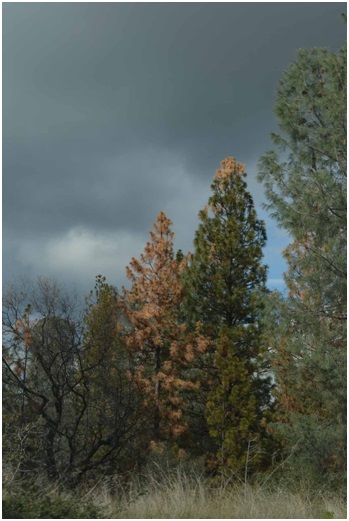 Some explanations would help to understand the situation. Research led to the Sierra National Forest office in North Fork where a a copy of “Bark Beetles in California Conifers – Are Your Trees Susceptible?” was obtained. There is a great deal to be learned from this 12-page publication and a short synopsis might be beneficial to all of us.
Some explanations would help to understand the situation. Research led to the Sierra National Forest office in North Fork where a a copy of “Bark Beetles in California Conifers – Are Your Trees Susceptible?” was obtained. There is a great deal to be learned from this 12-page publication and a short synopsis might be beneficial to all of us.
The following are excerpts from this publication that I tried to make logical and informative. It is by no means a complete discussion of the subject. Photographs of the damaged trees in and around North Fork follow the text.
Excerpts from: “Bark Beetles in California Conifers – Are Your Trees Susceptible?“
Bark beetles survive in trees that are stressed, diseased, or injured; either by human activity or during storms or wildfires. Bark beetles can increase dramatically when sufficient food is available. Typically, this is in the form of drought-stressed trees. High numbers of these small beetles (outbreak populations) attack trees en mass. Often many trees are killed over the landscape. In many years, more trees are killed by bark beetles than by fire!
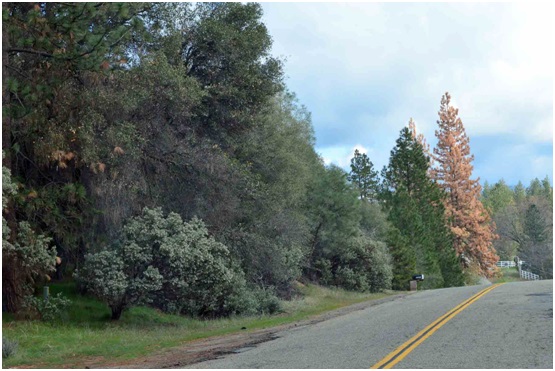 In the battle between trees and tree-killing beetles the two principle interacting factors are tree vigor and beetle numbers. When beetle populations are low, healthy trees often produce enough resinous pitch to drown and “pitchout” the beetles that attempt to enter. When trees are stressed they may be unable to produce sufficient amounts of defensive pitch. When beetle populations are high, even an apparently healthy tree may not be able to produce enough pitch to ward off hundreds of attacks (a mass attack). In addition, many beetles carry fungi that further impair the tree’s defense system.
In the battle between trees and tree-killing beetles the two principle interacting factors are tree vigor and beetle numbers. When beetle populations are low, healthy trees often produce enough resinous pitch to drown and “pitchout” the beetles that attempt to enter. When trees are stressed they may be unable to produce sufficient amounts of defensive pitch. When beetle populations are high, even an apparently healthy tree may not be able to produce enough pitch to ward off hundreds of attacks (a mass attack). In addition, many beetles carry fungi that further impair the tree’s defense system.
There are a number of different bark beetles, each has its own characteristics.
The Mountain Pine Beetle is native to the forests of Western North America… During low population levels, attacks are primarily on trees stressed by injury, poor site conditions, overcrowding root disease, or old age. As beetle populations increase, attacks may involve most trees over 6 inches in diameter…in the outbreak area, regardless of their apparent health.
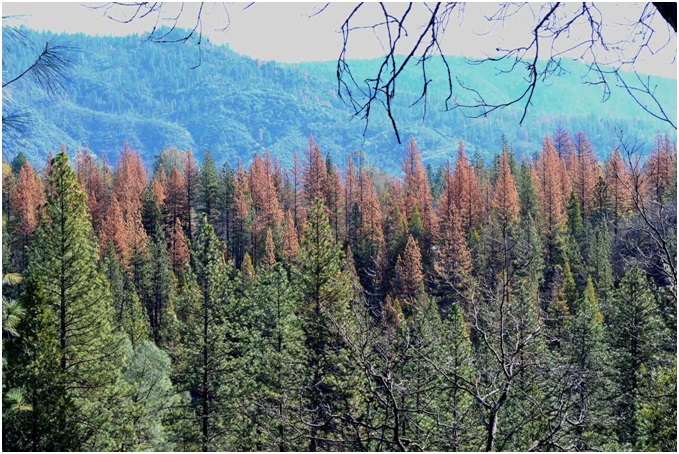 Attacking beetles release chemicals called pheromones that attract other beetles until a mass attack overcomes the tree. Attacks may spill over into adjacent trees causing what is known as a “group kill”. Crown fade on successfully attacked trees typically occurs within 4 to 10 months. Drought-stressed trees may fade in a shorter period of time. Mountain pine beetle adults fly from May through October, depending on temperatures… Female beetles create straight vertical galleries (between the bark and trunk) that can extend up to three feet or more. The eggs are laid alternately along the sides of the gallery. Larvae feed on phloem, constructing galleries at right angles to the parent galleries. The combination of beetle attacks, gallery construction and feeding, and staining fungi, cause the tree to die.
Attacking beetles release chemicals called pheromones that attract other beetles until a mass attack overcomes the tree. Attacks may spill over into adjacent trees causing what is known as a “group kill”. Crown fade on successfully attacked trees typically occurs within 4 to 10 months. Drought-stressed trees may fade in a shorter period of time. Mountain pine beetle adults fly from May through October, depending on temperatures… Female beetles create straight vertical galleries (between the bark and trunk) that can extend up to three feet or more. The eggs are laid alternately along the sides of the gallery. Larvae feed on phloem, constructing galleries at right angles to the parent galleries. The combination of beetle attacks, gallery construction and feeding, and staining fungi, cause the tree to die.
TREE SUSCEPTIBILITY
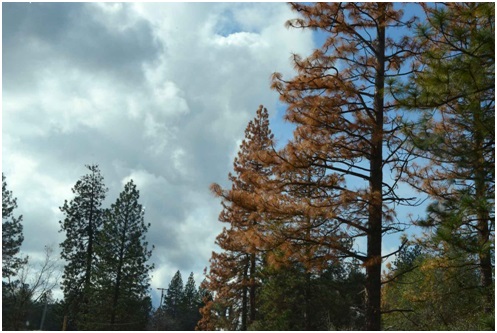 Stressed trees are not able to fend off bark beetle attacks… An individual tree may be of high importance for aesthetic or other values. Several types of treatments may be warranted to improve its health and vigor and protect it from successful attacks to bark beetles.” [Chemical treatments are usually prohibitively expensive]
Stressed trees are not able to fend off bark beetle attacks… An individual tree may be of high importance for aesthetic or other values. Several types of treatments may be warranted to improve its health and vigor and protect it from successful attacks to bark beetles.” [Chemical treatments are usually prohibitively expensive]
Widely spaced trees are typically less susceptible to successful attack by bark beetles… Less competition for water, light and nutrients facilitates tree growth and vigor, both of which are important in the defense against bark beetles.
SIGNS OF BEETLE INFESTATION ARE PITCH TUBES, small holes through the bark, or boring dust and/or frass (beetle excrement). Most beetle-attacked trees will have pitch tubes scattered over the tree bole. (trunk, for us lay people) Pitch tubes resulting from successful attacks are typically reddish in color and vary in size depending on the beetle species. White or cream colored pitch tubes may be indicative of unsuccessful attacks. Beetles may attack around mid-bole first and then fill in up and down. “
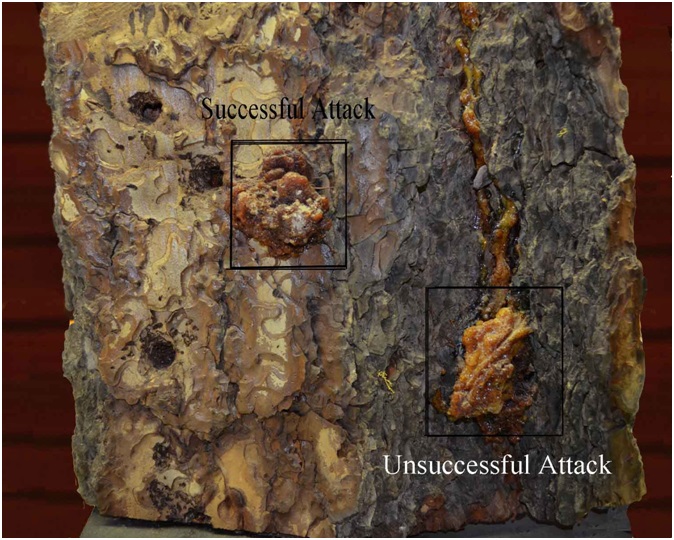 There is a sample piece of bark at the Sierra National Forest office in North Fork that shows successful and unsuccessful attacks. Here is a photo of the bark:
There is a sample piece of bark at the Sierra National Forest office in North Fork that shows successful and unsuccessful attacks. Here is a photo of the bark:
HOW TO TREAT TREES THAT HAVE BEEN ATTACKED. Once bark beetles have successfully attacked a tree there is generally nothing you can do to save it… Additional tree mortality in the immediate area may be reduced if trees are removed while still infested. This particularly applies to Jeffrey or Lodgepole pines.
MOST BARK BEETLES HAVE EMERGED BY THE TIME TREES HAVE RED-BROWN NEEDLES. Other beetles and larvae may be observed, but they are of little concern in causing mortality of additional trees. Most are beneficial wood decomposers – not tree killers.
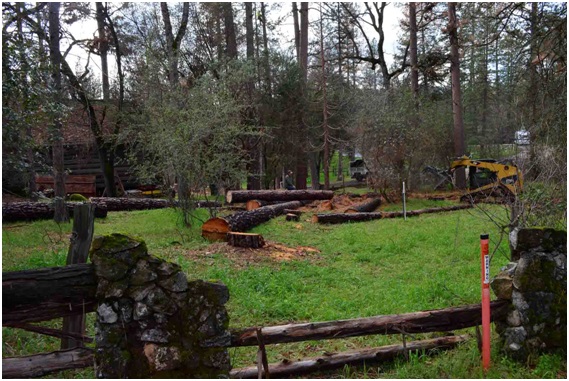 HOW TO PREVENT BARK BEETLE ATTACKS
HOW TO PREVENT BARK BEETLE ATTACKS
Thinning trees to a wide spacing is the best long-term solution to increase tree health and vigor.
Always clean up any recently blown down trees or fresh slash to avoid creating more habitat for beetle development.
Avoid causing injuries to trees.
During severe or protracted drought periods it may be prudent to use insecticides to protect unattacked trees… performed by a commercial applicator. [Very Expensive]
Watering your trees during severe or protracted drought periods can also give your trees a boost. Watering should occur early in the growing season by saturating the soil down to two feet near the outer edge of the tree branches, Be careful not to over water!
For a complete copy of “Bark Beetles in California Conifers – Are Your Trees Susceptible?” including photos of beetles, trees and cones, and how to identify infested trees, click here.
(Photos by Don Grove)

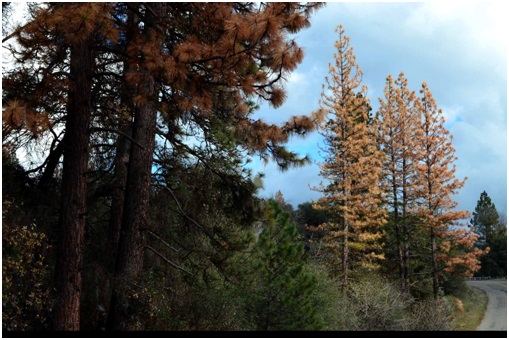


Please don’t look to just the Beetles! Western Pine Dwarf Mistletoe has also infiltrated our area and is leading to the majority of the dieoff you are seeing. This was brought in by people hauling firewood from the other side of the mountains. In other states where this has taken over, they have seen huge areas of trees die. Unfortunately there is very little we CAN do to stop it. Please see USDA reference material on this disease and how to stop its spread.
I have lived in the San Joaquin valley all my life. I am now 87 years old. I have always been an advocate of our beautiful state. It disturbs me to think of “beetles” whatever kind, that are feasting on our forever loving pines. I am familiar with the North Fork and Bass Lake area where family residences are and hope to continue to enjoy this area. While I understand chemicals are somewhat dangerous, it is probably the best choice of “mass- destruction” of these little insects. Good Luck.